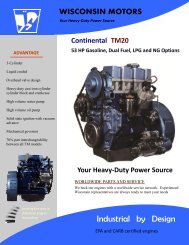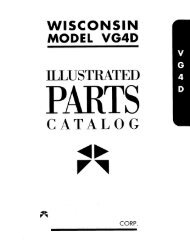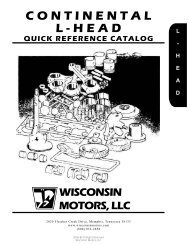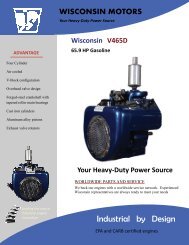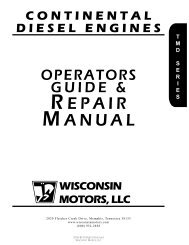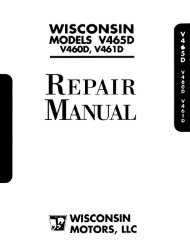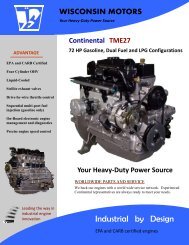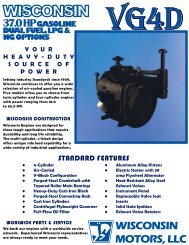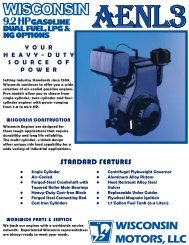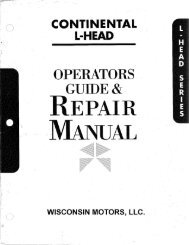WISCONSIN MODEL VG4D - Wisconsin Motors
WISCONSIN MODEL VG4D - Wisconsin Motors
WISCONSIN MODEL VG4D - Wisconsin Motors
Create successful ePaper yourself
Turn your PDF publications into a flip-book with our unique Google optimized e-Paper software.
1. Remove these covers frequently and clean out all<br />
dust and chaff. Be sure to replace covers.<br />
2. Open these covers frequently and clean out all<br />
dust and chaff. Be sure to close covers.<br />
3. Keep this space between cylinders free of dust<br />
and chaff.<br />
4. Read instructions on this air cleaner regarding its<br />
care. This is important. The entire pre-cleaner and<br />
air cleaner should be removed from the engine at<br />
least once a year, and washed in a cleaning fluid<br />
to clean out dirt gathered in the back fire trap in<br />
the top part of the air cleaner.<br />
5. Replace this oil filter cartridge every other oil<br />
change. If operating conditions are extremely dusty<br />
replace cartridge every oil change. Be sure that<br />
your replacement is a <strong>Wisconsin</strong> Micro-Fine filter.<br />
6. Do not allow shrouding to become damaged or badly<br />
dented as this will retard air flow.<br />
Never operate engine with air shrouding removed.<br />
This will retard air cooling.<br />
Always keep all parts of the engine clean.<br />
This will prolong engine life, and give more<br />
satisfactory operation.<br />
Every 4 to 8 hours, depending on dust conditions,<br />
check air cleaner and change oil. See Page 10.<br />
Every 8 hours check crankcase oil level. Keep filled<br />
to full marl: on oil gauge saber, but no more. See<br />
t’igo 3.<br />
Every 50 hours, drain crankcase and refill<br />
oil. See Lubrication, Pages 6 and 7.<br />
with fresh<br />
The intake system of a gasoline engine is designed<br />
so that the fuel may be vaporized and mixed with the<br />
correct amount of air for proper combustion in the<br />
cylinders. To vaporize the fuel, a certain amount of<br />
heat must be supplied to the intake manifold. The<br />
temperature of the air to the carburetor varies considerably<br />
between summer and winter weather, so that<br />
in designing the intake manifold a happy medium<br />
must be chosen for the amount of heat supplied. This<br />
heat is usually taken from the exhaust manifold<br />
through a connection called a hot spot, between the<br />
two manifolds. The size of this hot spot is very important.<br />
If it is too small, insufficient heat will be<br />
supplied to the inlet manifold and carburetor in cold<br />
weather, and poor vaporization of fuel and irregular<br />
operation of the engine will result, with loss of power.<br />
If the hot spot is too large, the inlet manifold and<br />
carburetor will be too hot in summer weather and this<br />
will result in heating the engine unnecessarily, and<br />
there will also be loss in power. There might also<br />
result, some vapor lock, due to overheating the fuel<br />
in the carburetor, or in the fuel feed lines to the<br />
carburetor. Vapor lock is fuel in a gaseous state, in<br />
the fuel lines or in the smaller passages in the carburetor,<br />
preventing the flow of fuel, thus stopping the<br />
engine.<br />
If an engine is stopped by vapor lock, there will be<br />
considerable difficulty in starting the engine again,<br />
until it has cooled off sufficiently to overcome the<br />
vapor lock, and thus allow the fuel to flow normally.<br />
Vapor lock, or a hot inlet manifold and carburetor,<br />
which will vaporize the fuel too rapidly, resulting in<br />
an over rich mixture, are the main reasons for hard<br />
starting of hot engines. This condition is more apt to<br />
occur with four cylinder, rather than with one or two<br />
cylinder engines.<br />
The following suggestions will help considerably to<br />
overcome these hard starting problems:<br />
If the engine has been running hard and is hot, do<br />
not stop it abruptly from full load, but remove the<br />
load and allow engine to run idle at 1000 to 1200<br />
R.P.M. for three to five minutes, depending on how<br />
hot the engine has been. This will reduce the internal<br />
temperature of the engine much faster than stopping<br />
the engine, and of course the external temperature,<br />
including the manifold and carburetor, will also reduce<br />
faster.<br />
[~-21NCH WIDE SAW GUT TO REDUCE<br />
~<br />
O TEMPERATURE<br />
SUGGESTION FOR CONTINUOUS<br />
HOT WEATHER OPERATION<br />
Fig. 18<br />
In extreme cases, four-cylinder engines which operate<br />
mainly in hot weather, can be benefitted by reducing<br />
the width of the hot spot between the inlet and exhaust<br />
manifolds, to about one half or less, by sawing<br />
in from each side with a hack saw. The width of the<br />
hack saw cut (about 1/32 inch)is sufficient to reduce<br />
the heat flow and reduce inlet manifold and carburetor<br />
temperatures, and improve hot starting conditions.<br />
See Fig. 18.<br />
TROUBLES<br />
CAUSES AND RE/~EDIES<br />
Three prime requisites are essential to starting and<br />
maintaining satisfactory operation of gasoline engines.<br />
They are:<br />
1. A proper fuel mixture in the cylinder.<br />
16



